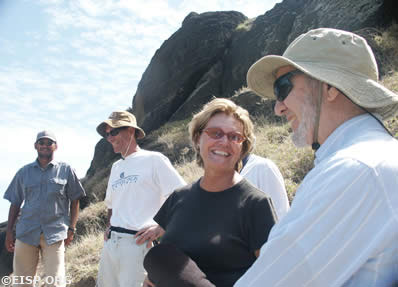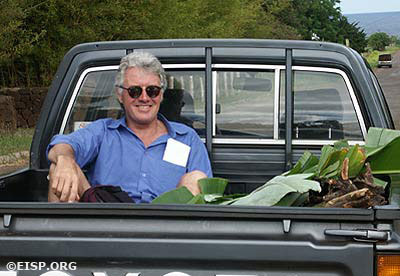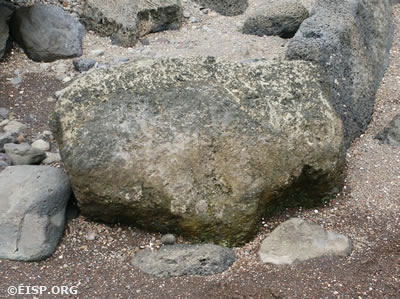Easter Island Statue Project History: October-November 2002

Cristián Arévalo Pakarati, Barry Rollett, Jo Anne Van Tilburg, and Jared Diamond at Rano Raraku. ©EISP/JVT/Photo: A. Hom.
Rano Raraku Interior Mapping Project
October-November 2002
Field Crew
Dr. Jo Anne Van Tilburg, UCLA, Project Director
Cristián Arévalo Pakarati, Project Co-Director
Gordon Hull, UCLA Rock Art Archive
Alice Hom, EISP Database Manager
Debra Isaac, Graphic Artist, UCLA Rock Art Archive
Bill White, Photographer
Goals and Methods
The specific goal of this field season was to augment previous efforts by accomplishing a digital and standard photographic survey of Section C. Further detailed measurements of all moai in Section C, as well as all of those standing outside of it on the quarry slopes, will also be accomplished. Cristián will initiate the sketch map of Section D, and Van Tilburg will field check the previous season’s field work in Section C as well as lay-out survey points for Section D. We previously used three single-frequency Ashtec GPS receivers, providing centimeter level accuracy, in our survey. It is based on an existing GPS station approximately 10 km west of the site. This station was set up by NASA in 1998 and placed our survey on the GPS datum WGS 84.
The survey was previously placed on the UTM (Universal Transverse Mercator) projection zone 12 – the same projection as was used by Cristino et al in Atlas Arqueólogica de Isla de Pascua,1981. Thus, we will provide consistent data. There is, however, a significant difference between earlier maps and our survey. Our map is based on a modern Global Positioning Survey (GPS) using the new WGS 84 figure of the earth.
In the Field
Cristián Arévalo Pakarati initiated a hand drawn detail map of each quarry and statue located in Section D. This map, which compliments that accomplished in the previous season for Section C, will contain on it the survey reference points. It will be used to illustrate specific archaeological and formal details of quarries and statues, and will serve as the reference guide for the computerized development using CAD of the GPS survey map described above.
We accomplished standard, black and white photography and digital photography of all standing and fallen statues in the interior of Rano Raraku. Overhead images of some were also accomplished. Photographs and negatives are contained in scanned computer files, along with historical photographs, excavation records, measurements, digital photographic records, and photogrammetric documentations. We also recorded details of rock art superimposed on statues and quarries.
Findings
The number of statues in Section D was estimated to be about 60, but the total number of features was not known. A fire had occurred in the quarry prior to our October arrival, and it revealed a series of features we designated AF I-AF IX. Three new heads, 1 shaped block (a possible torso), 2 fragments of statues and 3 new portions of papa were exposed. In Section D, we documented 44 moai, 17 heads/faces, and 9 blocks being shaped to form statues.
EISP will continue to document and describe, using the aforementioned digital mapping and photographic techniques, all statues in Section D during the next field season. Finally, we will correlate and file all findings in both Sections C and D in computer-based files, which will then be keyed to the digital field map produced in CAD.
Conservation and Public Outreach
EISP is the world’s largest and most fully detailed archive of moai descriptive data. It spans a time frame of 20 years and includes over 10,000 visual images; 4,000 graphic images; 46,000 metrics and hundreds of pages of fieldnotes, drawings and maps. All data are filed on CD-ROM and stored in archival conditions. Comparative analyses illustrate that all moai have been subjected to environmental damage. Every effort to restore, conserve or reconstruct moai, in or out of Rano Raraku, requires or depends upon these data. We have made detailed records, both visual and narrative, of the stone condition in the interior especially as it was recently impacted by fire.
As suggested by CONAF, EISP provides signs stating the nature of the project for the edification of tourists who passed by during our fieldwork. This was very successful, and encouraged tourists and guides to inquire about the project and discuss conservation of the statues relative to foot traffic patterns within the quarry.
Want to Know More?
Read the Dispatches from the 2002 Field Crew.
Related Record: Rano Raraku Interior, Moai RR-03C-011
Related Record: Ahu Tangi Uka
 English
English  Español
Español 
